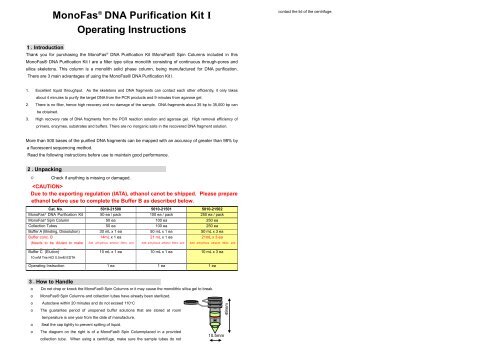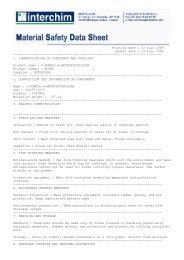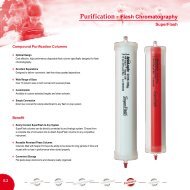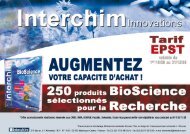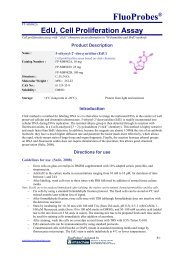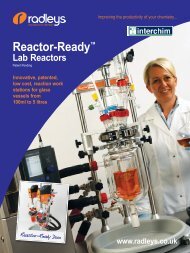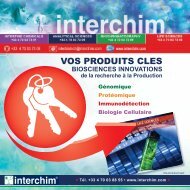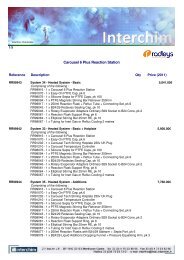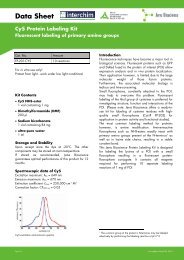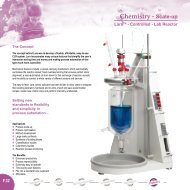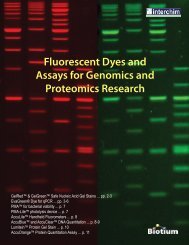MonoFas® DNA Purification Kit I Operating Instructions - Interchim
MonoFas® DNA Purification Kit I Operating Instructions - Interchim
MonoFas® DNA Purification Kit I Operating Instructions - Interchim
You also want an ePaper? Increase the reach of your titles
YUMPU automatically turns print PDFs into web optimized ePapers that Google loves.
Step 1: There is no need to dissolve the PCR products with Buffer A before adding to the spin column.Leaving the Buffer A in the spin column for a long time may cause leakage.Step 4: When treating more than 50uL sample, remove the solution in the collection tube after the step 4 andmove to the rinsing step.Step 6: Silica Monolith does not have any filter and provides an excellent liquid throughput, hence there is noneed for centrifuging after rinsing (step 6).Step 6: Buffer C consists of 10mM Tris-HCI+0.5mM EDTA (Free) (pH 8.5). It can be replaced withRNase/DNase free sterilized water. In this case, use ammonia water or aqueous potassium hydroxide toadjust the pH to 8.0-8.5, as the recovery changes depending on the pH.Step 3: Make sure that the gel is completely dissolved. If not, extend the heating time, raise the dissolvingtemperature, or stir during heating.Step : There is no need to centrifuge after rinsing (step 6).Step 8: Buffer C consists of 10mM Tris-HCI+0.5mM EDTA (Free) (pH 8.5). H 2O can be also used as theoriginal elution solution. In this case, use ammonia water or aqueous potassium hydroxide to adjust the pHto 7.0-8.5 as the recovery changes depending on the pH.6 . Protocol from Agarose GelWith this protocol, only <strong>DNA</strong> fragments can be purified from agarose gel. Please set the centrifuge at 9,000xg (10,000 rpm) and a heat block or water bath heated at 60 ℃ before use.DissolveBindingRinse1. Take the target band from the agarose gel andslice at a clean place.2. Weigh the gel and put the same amount ofBuffer A as the gel into the micro tube (eg: Gel50mg: Buffer A 50ul)3. Keep it at 60 °C for 5 minutes (to dissolvesample)4. Pipette the dissolved sample onto the spincolumn.5. Centrifuge (9,000xg, 30 seconds)6. Add Buffer B 500uL.7. Centrifuge (9,000xg, 30 seconds)Elute8. Switch the spin column to the micro centrifugetube and add Buffer C.9. Centrifuge (9,000xg, 1 minute)Step 1: Make sure that the gel is to be cut by a clean cutter or knife, and remove the unnecessary water.
7 . Protocol using a CentrifugeThe MonoFas ® <strong>DNA</strong> <strong>Kit</strong> I can be used with the handy desktop centrifuge. This protocol can be used for bothpurifications from PCR products and agarose gel. With the handy desktop centrifuge, the purification fromPCR products takes only 2 minutes and 7 minutes from agarose gel.Handy DesktopCentrifuge MachineNumber of CyclesMore than 6,200 rpm±20%(Fixed)CentrifugeAccelerationMore than 2,000 xg(19,600 m/s 2 )○ Recovery change by centrifuge method and time●Fragment <strong>DNA</strong> :35 bp●Fragment <strong>DNA</strong> :35 kbpLane #PCR Product+Buffer A(10 times)BindingWashingElutionItems Binding Rinsing Elution# ofcycles(rpm)CentrifugeTimeAdd the same amount ofBuffer A and dissolve(60°C, 5 Mins)# of cycles(rpm)CentrifugeTime# of cycles(rpm)Gel FragmentsHandy Desktop Centrifuge(2 Seconds)Buffer B 500μLHandy Desktop Centrifuge(1 minutes)Buffer C (10 - 50μL)Handy Desktop Centrifuge(2 Seconds)Recovery does not change depending on the number of revolutions and revolutiontime length.CentrifugeTimeM pHY Marker - - - - - -1 Unpurified PCR products - - - - - -2 Existing Centrifuge 10,00 30secs 10,000 1min 10,000 30secs3 Method Existing Centrifuge 5,000030secs 5,000 1min 5,000 30secs4 Method Handy Desktop2secs 1min 2secs5 Centrifuge Handy Desktop5mins 5 mins 5minsCentrifugeFragment sizes between 35 bp and 35 kbp can be purified by spinning down.Please make sure to have centrifuge for 1 minute after the rinsing step.8. TroubleshootingTrouble Possible cause SolutionsLow or no recoveryCannot obtain a goodresult in fluorescentsequencingThe restriction enzymedigestion is not working.The purified <strong>DNA</strong> is lessin quantity compared tothe <strong>DNA</strong> that wasconfirmed by theagarose gel.The absorbance ratioA260/280 of the purified<strong>DNA</strong> is low.Cannot apply thepurified <strong>DNA</strong> to theagarose gel.Cannot confirm oridentify the band of thepurified <strong>DNA</strong>.Inadequate amount of Buffer A was added Check the volume of buffer added to the sliced gel and PCRto the sliced gel and PCR reaction solution. reaction solution.The original elution buffer was notappliedproperly.Elution Buffer C is not diffusing on thesurface of the monolith.The gel is not completely dissolved.The amount of <strong>DNA</strong> for sequencingreaction is too little.The amount of <strong>DNA</strong> for sequencingreaction is too much.Inadequate enzyme concentration anddigestion time.The <strong>DNA</strong> that passed through the columnincludes ethanol and salt.Contaminants exist in the agarose gel<strong>DNA</strong>.Contaminants exist in the recovered <strong>DNA</strong>from the column.Some Buffer A remainingInadequate cleaning with Buffer BSome Buffer B remainingInadequate centrifugal rotations or timeInadequate vacuuming pressureSome Buffer B remaining<strong>DNA</strong> has been sheared.Agarose gel was not dissolved enough.<strong>DNA</strong> was decomposed by nuclease.Cloning efficiency is low. Buffer A is still remaining.Buffer B is still remaining.Agarose gel is mixed.Primer-dimer was spiked in the elutingsolution.Eluate contains ss<strong>DNA</strong>Add 10μL of Buffer A for every 10mg of sliced gel.Add 100μL of Buffer A for every 10μLsolution.PCR reactionMake sure that the original elution buffer was pH 8.0-8.5.Add Buffer C to the central part of the monolithic silicasurface.Check if the gel has been completely dissolved. Extend thedissolving time. During the dissolving, stir the sample a fewtimes.Increase the amount of <strong>DNA</strong> for sequencing reaction.Concentrate <strong>DNA</strong> by ethanol.Dilute the amount of <strong>DNA</strong> for sequencing reaction.Increase the amount of the enzyme and the digestion time.Digest it at the adequate temperature and use an optimalbuffer.Precipitate the <strong>DNA</strong> by using ethanol.Set the volume of <strong>DNA</strong> to 10% of the total reaction volume.Quantitate the amount of <strong>DNA</strong> on the agarose gel by usingethidium bromide.Re-purify the eluted <strong>DNA</strong> by using the spin column.Set the volume of <strong>DNA</strong> to 10% of the total reaction volume.Precipitate the <strong>DNA</strong> by using ethanol and recover it.If necessary, purify it again with the monolith column.More than 20 in Hg of vacuuming pressure is needed in thesuction method.If the vacuuming is inadequate, use the centrifugationmethod.Re-purify the eluted <strong>DNA</strong> by using the spin column.Double up the amount of the Binding Buffer.Mix agarose gel and Buffer A well.Confirm the guarantee period of each buffer solution.Sterilize them again.Check each step and protocol and make sure to followthem.A primer-dimer bigger than 20bp was formed and was notremoved completely.After the adsorption step, use 35% guanidine hydrochloridesolution to rinse.Then use Rinsing Buffer B and move to the Elution step.Prepare a reaction solution set the temperature at 95℃ andincubate for 2 minutes. Cool it down gradually.Then add enzyme to oxidize.Smears can be seen by gel electrophoresis Salt might be contained in the eluate solution
9 . Storing of the kit○○Store the MonoFas ® <strong>DNA</strong> <strong>Purification</strong> <strong>Kit</strong> lin a clean place with a constant temperature.The guarantee periods of each unopened buffer solution being stored at room temperature is oneyear from the manufacturing date.Products Contents Cat. No. Volume10 . WarrantyThe MonoFas ® <strong>DNA</strong> <strong>Kit</strong> lis manufactured, inspected, packaged and shipped under our strict standards ofquality control. Should you find any defect in performance, please contact us.This product is manufactured for the purpose of <strong>DNA</strong> purification only.We regret that we cannot accept any claim when their performance has deteriorated due to non-compliancewith the above operating instructions.The guarantee periods of each unopened buffer solution being stored at room temperature is one year fromthe manufacturing date.MonoFas <strong>DNA</strong> <strong>Purification</strong><strong>Kit</strong>IMonoFas <strong>DNA</strong> Pufirication<strong>Kit</strong> IIMonoFas <strong>DNA</strong> <strong>Purification</strong><strong>Kit</strong> I IIFragment <strong>DNA</strong> <strong>Purification</strong> <strong>Kit</strong> 5010-21500 50pcsGenomic <strong>DNA</strong> <strong>Purification</strong> <strong>Kit</strong> from WholeBlood5010-21501 100pcs5010-21502 250pcs5010-21511 96pcsAdaptor for Micro Tube Centrifuge 5010-21513 6pcsPlasmid Extraction <strong>Kit</strong> 5010-21503 50pcs5010-21504 100pcs5010-21505 250pcs11 . Product InformationProducts Cat. No. VolumeMonoFas® <strong>DNA</strong> <strong>Purification</strong> <strong>Kit</strong> lBuffer A 5010-21506 50 mLMonoFas® <strong>DNA</strong> <strong>Purification</strong> <strong>Kit</strong> lBuffer B 5010-21507 60 mLMonoFas® <strong>DNA</strong> <strong>Purification</strong> <strong>Kit</strong> lBuffer C 5010-21508 10 mLMonoTip C18 Desalting / Enrichment of Protein 5010-21001 24pcsMonoTip mini C18Desalting / Enrichment of Small amount ofProtein5010-21000 96pcs5010-21202 24pcs5010-21200 96pcsMonoTip Trypsin Trypsin Digestion of Protein 5010-21012 24pcs5010-21010 96pcsMonoTip TiO Selective Enrichment of Phosphopeptide 5010-21007 24pcs5010-21005 96pcs"Based on monolithic technology, Merck KGaA, Darmstadt, Germany"1 -0


